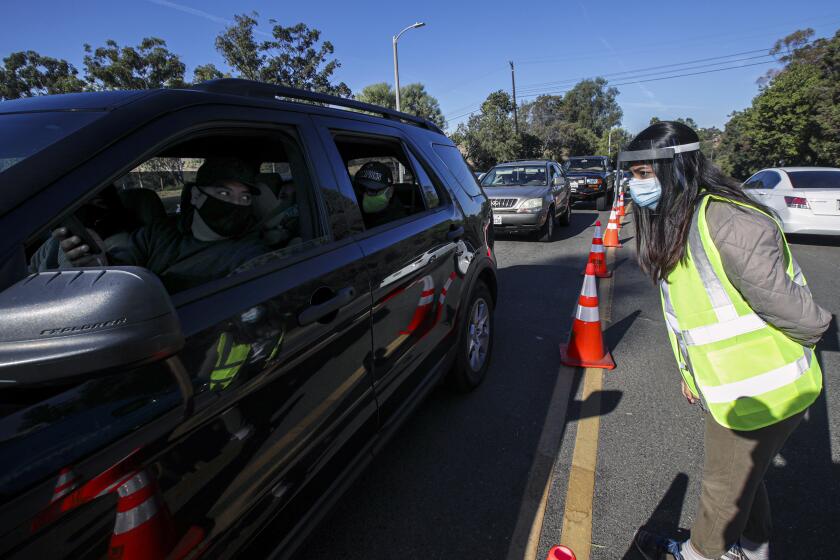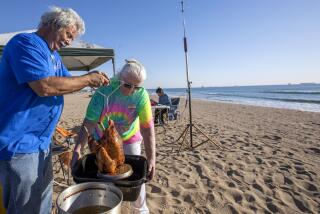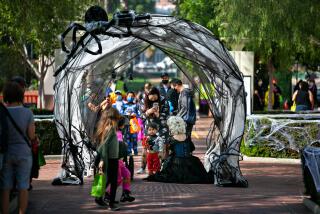How should Thanksgiving be celebrated during the pandemic? Officials urge staying home

- Share via
SAN FRANCISCO — How should Thanksgiving be celebrated in the middle of the worst global pandemic in a century?
As safely as possible, experts say. Think small, and stay at home.
Thanksgiving offers profound risks if large numbers of guests hailing from different households — especially those traveling from far away — gather. Those who are elderly or have underlying medical conditions are at particular risk for severe illness or death should they be infected with the coronavirus.
Testing before Thanksgiving also isn’t a sure way to stave off the spread of the illness. If a person is tested shortly after becoming infected and before the virus has reproduced enough copies of itself, a test could fail to detect the virus and produce a false negative result.
People can be highly contagious even when showing no signs of illness.
A negative test “should not be used as a free pass to gather with others or to not follow the basic core public health measures that are essential to keeping us all healthy,” said Dr. Christina Ghaly, Los Angeles County’s director of health services.
That’s why the safest bet is to stick to your own household for the holiday this year, public health officials say.
“I know everybody wants to know what to do for Thanksgiving, and the basic answer — to be the Grinch who stole Thanksgiving — is not to do it,” Dr. George Rutherford, an epidemiologist and infectious diseases expert at UC San Francisco, said at a recent campus town hall meeting.
“It’s just going to be my wife and me. I already told the kids, ‘Forget it,’” said Rutherford, who has six adult children.
Feel free to make a special dinner. But to “host,” it’s safest to connect with extended friends and family through video calls or the telephone, while keeping in-person guests among only the members of your household.
California joined Texas as the first states to confirm 1 million coronavirus cases. The grim milestone comes just before Thanksgiving.
California has seen significant jumps in coronavirus infections, hospitalizations and positive test rates, and officials expect deaths to rise too. “This much of an increase in cases may very well result in tremendous suffering and tragic deaths down the road,” said Barbara Ferrer, the Los Angeles County director of public health.
On Friday, Gov. Gavin Newsom issued a travel advisory encouraging residents to stay local and avoid nonessential out-of-state travel. It also asks those who arrive from another state or country to self-quarantine for 14 days.
“Please choose to be part of the solution because it’s going to take all of us to avoid increased heartbreak,” Ferrer said. “We’re actually recommending this Thanksgiving be a stay-at-home Thanksgiving.”
Ferrer said she won’t be driving this year for Thanksgiving to see her grandchildren, who live in a state that has a lot of coronavirus cases.
“It’s just not a good idea. And I’ll be really sad about this. Like all of you, I wish things were really different, but they’re not,” Ferrer said. “I don’t want to be one of the people that’s contributing to ... increasing cases that could result in other people getting sick and even dying.”
Limiting gatherings to within your immediate household means only those who currently live with you and share common spaces in your housing unit, officials say. That doesn’t include college students or other family members who live elsewhere.
“Obviously, the preference is for people not to be flying home for the holidays — for students or for others,” Ferrer said.
Health officials nationally and in California continue to urge people to avoid travel, which raises the risk of contracting and spreading the coronavirus.
“What we don’t want to have happen is have all these kids flying across the country for four days and then fly back again. That’s just unnecessary mixing,” Rutherford said in a subsequent interview. “The basic advice is: Stay within your pod. Stay within your bubble. Stay within your household.”
If students do fly home, some colleges are recommending they don’t return to campus until after the new year, Ferrer said, “so that you’re not really exposing lots more people when you come back here to finish out the semester.”
A person infected with the coronavirus on average goes on to infect two to four more people. One person can easily be responsible for the infection of more than 1,000 people after 10 cycles of virus transmission.
The advisory encourages residents to avoid nonessential travel. It also asks those arriving from another state or country to quarantine for 14 days.
Public health experts are extremely concerned about large gatherings during Thanksgiving as the virus surges nationally to record levels, with more than 100,000 people infected every day.
The pandemic’s first global spread coincided with a holiday quite like Thanksgiving in China: the Lunar New Year. Celebrations proceeded in Wuhan, the global epicenter of the pandemic, even though there were ample warnings the virus was spreading. And it hitched a ride with travelers as they fled the region just before a quarantine was enforced.
Dinners have also been shown to be a big spreader of the coronavirus. Disease investigators in Arizona who studied an outbreak tied to 60 people found that many of the cases probably stemmed from transmission at an indoor potluck dinner, where attendees did not wear masks, and a subsequent graduation dinner with more than two dozen attendees. Two of those who fell ill had to go to an emergency room, and one required critical care.
This year, the American Automobile Assn. estimates that 2.4 million Americans will still travel by air for Thanksgiving, a 48% decline from last year, and about 48 million will travel by car, a 4% drop.
If you are going to have guests, there are ways to make your celebration safer. Dr. Sara Cody, the health officer for Santa Clara County and one of the key architects of the nation’s first regional stay-at-home order, will have her mother, who is in her 80s, over for Thanksgiving.
“She will be outside, wrapped in blankets, greater than 10 feet from where I am. So that’s one way to do it,” Cody said.
While urging people to celebrate with only their immediate households, “we also understand that after an extraordinarily difficult year, people want to come together and find some nourishment in the company of family and friends,” Cody said. “We have guidelines for how to do that safely: Chief among them is to gather outdoors.”
California still generally prohibits large gatherings and has outlined the following requirements:
- Gatherings are limited to no more than three households and should be for a duration of no more than two hours.
- Gatherings are to be held outside in counties in the state’s most restrictive, or purple, tier.
- Gatherings in counties in the less restrictive tiers may occur indoors, although they’re still strongly discouraged. Hosts should increase fresh air circulation by opening windows or doors as much as possible, especially in the rooms where people are gathering.
- Attendees need to be able to maintain six feet of distance away from people not in their household.
- As much as possible, food or beverages should be served by someone who washes their hands often and wears a mask.
- Masks should be worn as often as possible, and removed only when eating or drinking.
- Higher-risk people, such as the elderly or those with chronic health conditions, should not attend gatherings. But if they do, they should spend as much time outside or near outside air flow; wear a respirator or surgical mask instead of a cloth mask and minimize time at the event with the mask off; and spend a shorter time at the gathering.
Los Angeles, San Diego, Riverside, San Bernardino and Imperial counties are among the counties in the purple tier in Southern California.
Health experts continue to warn against gatherings with anyone outside your household during the holidays.
If three households are coming together, Rutherford said, one idea to keep things safer is to assign each group its own table.
“This should not be like the sort of wedding reception where the father of the bride flits from table to table knocking over drinks and chatting everybody up.”
In California’s Yolo County, just west of Sacramento and home to UC Davis, health officials went a step further and specified in a health order issued last month that celebrations and get-togethers must be capped at 16 people.
“The more people interact and the longer they interact, the higher the risk of getting and spreading COVID-19,” the order says. “The Yolo County Health Officer strongly discourages gatherings of any size.”
The number of households you interact with should be kept stable, experts say. Attending multiple gatherings over a short period increases your risk.
Another thing to consider when hosting a gathering is the rate of COVID-19 infection in a guest’s home community, which can be checked using the peer-reviewed COVID-19 Risk Assessment Planning Tool online, built by researchers at Georgia Tech.
Before the state issued its travel advisory Friday, L.A. County officials were recommending that residents who return from travel quarantine themselves for 14 days. That means restricting your activities over those two weeks as much as possible — and not going out to the grocery store or to restaurants, and relying on delivery.
“You can go out by yourself and take a walk; we don’t have a problem with that,” Ferrer said. “But, no, we don’t want you going into restaurants and sitting and eating outside, and we don’t want you going into retail establishments either.”
More to Read
Sign up for Essential California
The most important California stories and recommendations in your inbox every morning.
You may occasionally receive promotional content from the Los Angeles Times.














